 y.layout.grid.PartitionGrid
y.layout.grid.PartitionGrid
|
Search this API | ||||||||
| PREV CLASS NEXT CLASS | FRAMES NO FRAMES | ||||||||
| SUMMARY: NESTED | FIELD | CONSTR | METHOD | DETAIL: FIELD | CONSTR | METHOD | ||||||||
java.lang.Objecty.layout.grid.PartitionGrid
public class PartitionGrid
This class represents a partition grid that partitions the drawing area into rectangular partition cells. Such a structure allows, for example, to model vertical/horizontal swimlanes which are often used in flow diagrams to separate logical units.
The grid consists of rows and columns that are created using the corresponding constructors of this class or methods
addRow() and addColumn(). The PartitionGrid object has to be registered with the graph
using the DataProvider key PARTITION_GRID_DPKEY.
Each node can be assigned to a PartitionCellId which represents a set of partition cells.
The mapping has to be registered with the graph using DataProvider key PARTITION_CELL_DPKEY.
Simple partition cell identifiers which represent a single partition cell, i.e., a row/column pair, can be created
using method createCellId(RowDescriptor, ColumnDescriptor) or createCellId(int, int).
Nodes can also be mapped to a partition cell identifier that represents a multi-cell, i.e., a cell spanning
multiple columns and rows.
Please note, however, that multi-cells are not allowed to overlap each other. This means that the user has to
ensure that each partition cell (row/column pair) is associated with at most one partition cell identifier.
The multi-cell identifier can be created using methods
createCellSpanId(RowDescriptor, ColumnDescriptor, RowDescriptor, ColumnDescriptor),
createCellSpanId(int, int, int, int), createCellSpanId(Collection, Collection),
createColumnSpanId(int), and createRowSpanId(int).
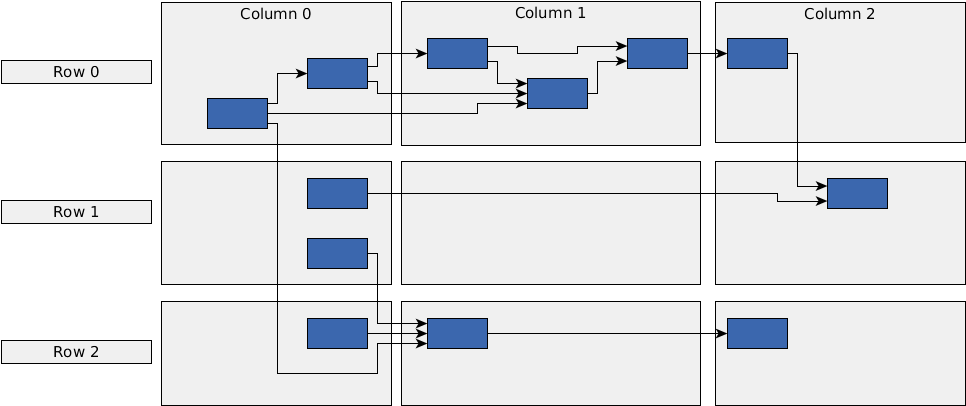
The partition cell identifier of a group node is not inherited by its non-group descendant. Hence, each non-group descendant has to be manually assigned to a partition cell identifier. In addition, a group node mapped to a column/row span partition cell identifier represents the associated column/row. Thus, its boundary corresponds to that of the column/row and edges incident to such a group node are not considered during the layout. Since the boundary of a group node always encompasses all of its children, don't assign a partition cell identifier to layout the group as normal.
setColumnOrderOptimizationEnabled(boolean)
or setRowOrderOptimizationEnabled(boolean) has no effect.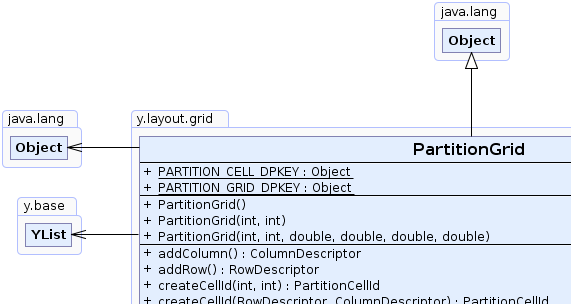 |
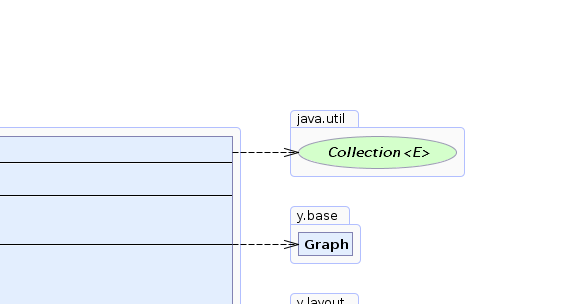 |
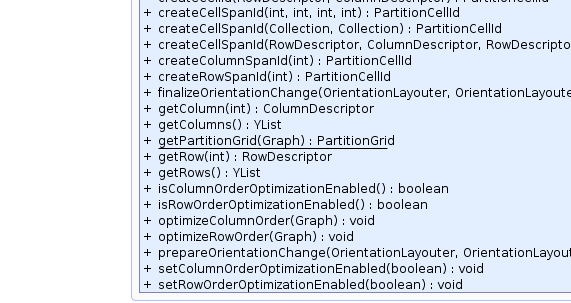 |
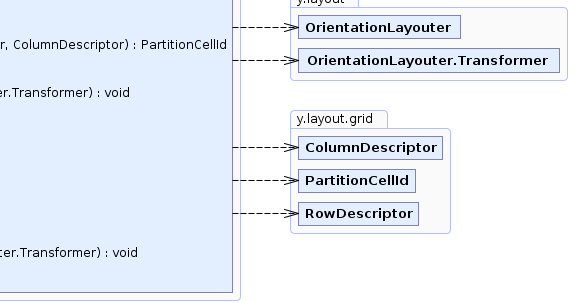 |
| Field Summary | |
|---|---|
static java.lang.Object |
PARTITION_CELL_DPKEY
A DataProvider key for storing a set of partition cells for each node
Each node is placed inside the columns/rows defined by the corresponding PartitionCellId identifier. |
static java.lang.Object |
PARTITION_GRID_DPKEY
A DataProvider key for storing the partition grid structure
If the DataProvider contains a partition grid structure, this structure will be considered during
layout (provided that the layout algorithm supports such constraints). |
| Constructor Summary | |
|---|---|
PartitionGrid()
Creates a new empty instance of PartitionGrid. |
|
PartitionGrid(int rowCount,
int columnCount)
Creates an instance of PartitionGrid with the given number of rows and columns. |
|
PartitionGrid(int rowCount,
int columnCount,
double rowInsets,
double columnInsets,
double minRowSize,
double minColumnSize)
Creates an instance of PartitionGrid with the given number of rows and columns as well as with given
insets and minimum sizes. |
|
| Method Summary | |
|---|---|
ColumnDescriptor |
addColumn()
Adds a new column to the PartitionGrid instance. |
RowDescriptor |
addRow()
Adds a new row to the PartitionGrid instance. |
PartitionCellId |
createCellId(int rowIndex,
int columnIndex)
Creates a partition cell identifier that represents the cell defined by the given column
and row index. |
PartitionCellId |
createCellId(RowDescriptor rd,
ColumnDescriptor cd)
Creates a partition cell identifier that represents the cell defined by the given
column and row. |
PartitionCellId |
createCellSpanId(java.util.Collection rowList,
java.util.Collection columnList)
Creates a partition cell identifier that represents a multi-cell spanning multiple columns
and rows. |
PartitionCellId |
createCellSpanId(int fromRowIndex,
int fromColIndex,
int toRowIndex,
int toColIndex)
Creates a partition cell identifier that represents a multi-cell spanning multiple columns
and rows. |
PartitionCellId |
createCellSpanId(RowDescriptor fromRow,
ColumnDescriptor fromCol,
RowDescriptor toRow,
ColumnDescriptor toCol)
Creates a partition cell identifier that represents a multi-cell spanning multiple columns
and rows. |
PartitionCellId |
createColumnSpanId(int columnIndex)
Creates a partition cell identifier that represents a cell spanning a whole column. |
PartitionCellId |
createRowSpanId(int rowIndex)
Creates a partition cell identifier that represents a cell spanning a whole row. |
void |
finalizeOrientationChange(OrientationLayouter orientationLayouter,
OrientationLayouter.Transformer transformer)
Finalizes the orientation changes and is called at the end of the OrientationLayouter stage. |
ColumnDescriptor |
getColumn(int index)
Returns the column with the given index. |
YList |
getColumns()
Returns the columns of the partition grid. |
static PartitionGrid |
getPartitionGrid(Graph graph)
Returns the PartitionGrid instance associated with the given graph. |
RowDescriptor |
getRow(int index)
Returns the row with the given index. |
YList |
getRows()
Returns the list of rows of the partition grid. |
boolean |
isColumnOrderOptimizationEnabled()
Returns whether or not the order of the columns should be chosen automatically to minimize edge lengths. |
boolean |
isRowOrderOptimizationEnabled()
Returns whether or not the order of the rows should be chosen automatically to minimize edge lengths. |
void |
optimizeColumnOrder(Graph g)
Optimizes the order of the columns of the PartitionGrid for the given graph. |
void |
optimizeRowOrder(Graph g)
Optimizes the order of the rows of the PartitionGrid for the given graph. |
void |
prepareOrientationChange(OrientationLayouter orientationLayouter,
OrientationLayouter.Transformer transformer)
Prepares for the orientation changes and is called at the beginning of the OrientationLayouter stage. |
void |
setColumnOrderOptimizationEnabled(boolean enabled)
Specifies whether or not the order of the columns should be chosen automatically to minimize edge lengths. |
void |
setRowOrderOptimizationEnabled(boolean enabled)
Specifies whether or not the order of the rows should be chosen automatically to minimize edge lengths. |
| Methods inherited from class java.lang.Object |
|---|
clone, equals, finalize, getClass, hashCode, notify, notifyAll, toString, wait, wait, wait |
| Field Detail |
|---|
public static final java.lang.Object PARTITION_GRID_DPKEY
DataProvider key for storing the partition grid structure
If the DataProvider contains a partition grid structure, this structure will be considered during
layout (provided that the layout algorithm supports such constraints).
DataProvider with method
DataProviders.createConstantDataProvider(Object) using the PartitionGrid instance as
parameter.public static final java.lang.Object PARTITION_CELL_DPKEY
DataProvider key for storing a set of partition cells for each node
Each node is placed inside the columns/rows defined by the corresponding PartitionCellId identifier.
Instances can be shared among multiple nodes, but don't have to be shared.
PartitionCellId| Constructor Detail |
|---|
public PartitionGrid()
PartitionGrid.
public PartitionGrid(int rowCount,
int columnCount)
PartitionGrid with the given number of rows and columns.
rowCount - the number of rowscolumnCount - the number of columns
public PartitionGrid(int rowCount,
int columnCount,
double rowInsets,
double columnInsets,
double minRowSize,
double minColumnSize)
PartitionGrid with the given number of rows and columns as well as with given
insets and minimum sizes.
rowCount - the number of rowscolumnCount - the number of columnsrowInsets - the top and bottom insets of the rowscolumnInsets - the left and right insets of the columnsminRowSize - the minimum row heightminColumnSize - the minimum column width| Method Detail |
|---|
public boolean isColumnOrderOptimizationEnabled()
For all columns where ColumnDescriptor.setIndexFixed(boolean) is set to true, the relative
ordering given by the indices is preserved. The remaining columns may be sorted again so that the overall edge
lengths are minimized.
true if the order is chosen automatically, false otherwisesetColumnOrderOptimizationEnabled(boolean)public void setColumnOrderOptimizationEnabled(boolean enabled)
For all columns where ColumnDescriptor.setIndexFixed(boolean) is set to true, the relative
ordering given by the indices is preserved. The remaining columns may be sorted again so that the overall edge
lengths are minimized.
public boolean isRowOrderOptimizationEnabled()
For all rows where RowDescriptor.setIndexFixed(boolean) is set to true, the relative
ordering given by the indices is preserved. The remaining rows may be sorted again so that the overall edge
lengths are minimized.
true if the order is chosen automatically, false otherwisesetRowOrderOptimizationEnabled(boolean)public void setRowOrderOptimizationEnabled(boolean enabled)
For all rows where RowDescriptor.setIndexFixed(boolean) is set to true, the relative
ordering given by the indices is preserved. The remaining rows may be sorted again so that the overall edge
lengths are minimized.
public PartitionCellId createColumnSpanId(int columnIndex)
partition cell identifier that represents a cell spanning a whole column.
A group node mapped to such a partition cell identifier represents the column, i.e., its enclosing boundary corresponds to that of the column. The boundary does not depend on the partition cells associated with the group's descendants. Hence, each non-group descendant has to be manually assigned to one of the partition cells. Furthermore, edges incident to such a group node are not considered during the layout.
columnIndex - the column index of the column defining the cell
PartitionCellId instance
public PartitionCellId createCellSpanId(int fromRowIndex,
int fromColIndex,
int toRowIndex,
int toColIndex)
partition cell identifier that represents a multi-cell spanning multiple columns
and rows.
The partition cell identifier represents all cells defined by a row with index between fromRowIndex
and toRowIndex (both including) and a column with index between fromColIndex and
toColIndex (both including).
A group node mapped to such a partition cell identifier represents the multi-cell, i.e., its boundary corresponds to the smallest rectangle containing all partition cells specified by the partition cell identifier. The boundary does not depend on the partition cells associated with the group's descendants. Hence, each non-group descendant has to be manually assigned to one of the partition cells. Furthermore, edges incident to such a group node are not considered during the layout.
fromRowIndex - the row index of the topmost row defining the cellfromColIndex - the column index of the leftmost column defining the celltoRowIndex - the row index of the bottommost row defining the celltoColIndex - the column index of the rightmost column defining the cell
PartitionCellId instance
public PartitionCellId createCellSpanId(java.util.Collection rowList,
java.util.Collection columnList)
partition cell identifier that represents a multi-cell spanning multiple columns
and rows.
The partition cell identifier represents all cells spanned by the columns of columnList and rows of
rowList.
A group node mapped to such a partition cell identifier represents the multi-cell, i.e., its boundary corresponds to the smallest rectangle containing all partition cells specified by the partition cell identifier. The boundary does not depend on the partition cells associated with the group's descendants. Hence, each non-group descendant has to be manually assigned to one of the partition cells. Furthermore, edges incident to such a group node are not considered during the layout.
rowList - the rows defining the cellcolumnList - the columns defining the cell
PartitionCellId instance
public PartitionCellId createCellSpanId(RowDescriptor fromRow,
ColumnDescriptor fromCol,
RowDescriptor toRow,
ColumnDescriptor toCol)
partition cell identifier that represents a multi-cell spanning multiple columns
and rows.
The partition cell identifier represents all cells defined by a row between fromRow and
toRow (both including) and a column between fromRow and toCol (both including).
A group node mapped to such a partition cell identifier represents the multi-cell, i.e., its boundary corresponds to the smallest rectangle containing all partition cells specified by the partition cell identifier. The boundary does not depend on the partition cells associated with the group's descendants. Hence, each non-group descendant has to be manually assigned to one of the partition cells. Furthermore, edges incident to such a group node are not considered during the layout.
fromRow - the topmost row defining the cellfromCol - the leftmost column defining the celltoRow - the bottommost row defining the celltoCol - the rightmost column defining the cell
PartitionCellId instancepublic PartitionCellId createRowSpanId(int rowIndex)
partition cell identifier that represents a cell spanning a whole row.
A group node mapped to such a partition cell identifier represents the row, i.e., its enclosing boundary corresponds to that of the row. The boundary does not depend on the partition cells associated with the group's descendants. Hence, each non-group descendant has to be manually assigned to one of the partition cells. Furthermore, edges incident to such a group node are not considered during the layout.
rowIndex - the row index of the row defining the cell
PartitionCellId instancepublic static PartitionGrid getPartitionGrid(Graph graph)
PartitionGrid instance associated with the given graph.
graph - the given graph
PartitionGrid of the graph or null if the graph has no associated partition gridpublic RowDescriptor addRow()
row to the PartitionGrid instance.
The index of the row (as returned by RowDescriptor.getIndex()) is equal to the size of the list returned
by getRows().
RowDescriptor instancepublic ColumnDescriptor addColumn()
column to the PartitionGrid instance.
The index of the column (as returned by ColumnDescriptor.getIndex()) is equal to the size of the list
returned by getColumns().
ColumnDescriptor instancepublic RowDescriptor getRow(int index)
row with the given index.
index - the index of the row to be returned
row with the given index or null if no such row existspublic ColumnDescriptor getColumn(int index)
column with the given index.
index - the index of the column to be returned
column with the given index or null if no such column existspublic YList getRows()
partition grid.
rows of this PartitionGridpublic YList getColumns()
partition grid.
columns of this PartitionGrid
public PartitionCellId createCellId(RowDescriptor rd,
ColumnDescriptor cd)
partition cell identifier that represents the cell defined by the given
column and row.
rd - the row defining the cellcd - the column defining the cell
PartitionCellId instance
java.lang.IllegalArgumentException - if the given column/row is null
public PartitionCellId createCellId(int rowIndex,
int columnIndex)
partition cell identifier that represents the cell defined by the given column
and row index.
rowIndex - the row index of the row defining the cellcolumnIndex - the column index of the column defining the cell
PartitionCellId instance
java.lang.IllegalArgumentException - if the given column/row index is not validpublic void optimizeRowOrder(Graph g)
PartitionGrid for the given graph.
setRowOrderOptimizationEnabled(boolean) to true.g - the given graphpublic void optimizeColumnOrder(Graph g)
PartitionGrid for the given graph.
setColumnOrderOptimizationEnabled(boolean) to true.g - the given graph
public void finalizeOrientationChange(OrientationLayouter orientationLayouter,
OrientationLayouter.Transformer transformer)
OrientationLayouter stage.
Points are transferred to their final positions through
OrientationLayouter.Transformer.finalizeTransform(YPoint).
orientationLayouter - an OrientationLayouter instancetransformer - an OrientationLayouter.Transformer instanceOrientationLayouter
public void prepareOrientationChange(OrientationLayouter orientationLayouter,
OrientationLayouter.Transformer transformer)
OrientationLayouter stage.
Original points are transferred to their temporary positions through
OrientationLayouter.Transformer.initTransform(YPoint).
orientationLayouter - an OrientationLayouter instancetransformer - an OrientationLayouter.Transformer instanceOrientationLayouter
|
© Copyright 2000-2025, yWorks GmbH. All rights reserved. |
||||||||
| PREV CLASS NEXT CLASS | FRAMES NO FRAMES | ||||||||
| SUMMARY: NESTED | FIELD | CONSTR | METHOD | DETAIL: FIELD | CONSTR | METHOD | ||||||||